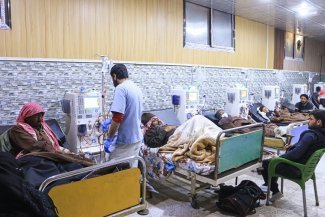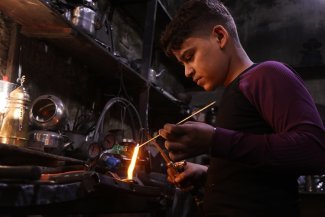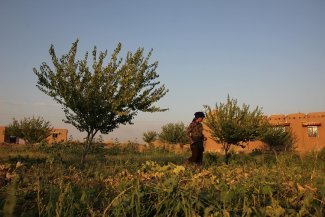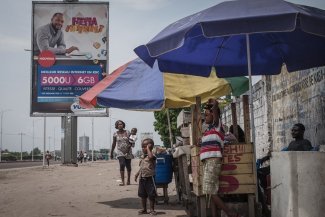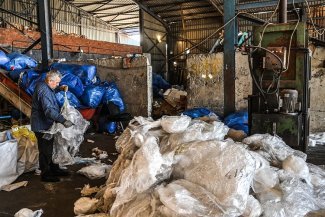

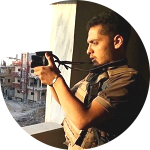
The site of an attack on 9 December 2023 by the Syrian regime in Idlib in which civilians were killed and injured.
Israel’s war on Gaza, which began on 7 October after the Hamas attack on Israel, has also impacted neighbouring Syria. The conflict in the country has been going on for almost thirteen years, exacerbated by the intervention and machinations of regional powers, or those with a key presence in the region, such as the US, Iran, Israel, Turkey and Russia. Now, the Gaza conflict has partially spilled over into Syrian territory, with the involvement of Iran, which supports Hamas, and the US, which backs Israel. Meanwhile, Russia and the Syrian regime continue to bombard Syria’s north-western region.
The war in Syria has claimed over 600,000 lives, according to the Syrian Observatory for Human Rights (SOHR). Some six million people have been internally displaced and 6.5 million have become refugees in neighbouring or European countries, according to the United Nations High Commissioner for Refugees (UNHCR). These figures reflect the scale of the horror in this forgotten war involving major powers, all pursuing their own interests.
To understand the situation in Syria, one has to analyse its complex geography and how control over the country is distributed.
Bashar al-Assad’s regime initially lost large areas to armed opposition factions, Kurdish factions and later to the Islamic State terrorist group. But Russia’s military intervention in September 2015 gradually contributed to tipping the balance of power in favour of the Assad regime, which it supports. The latter now controls over 63 per cent of the territory, thanks to military campaigns pursuing a scorched-earth policy against Syrian cities, with aerial support from Russia and military backing from Iran and Lebanon’s Hezbollah.
The Syrian regime has control over the coast, Damascus, the south and part of the north of the country. It shares that control with Iranian militias and Russia – which holds the Hmeimim airbase from where it launches military operations. Russia also controls airports and ports in collaboration with the regime. In southern Syria, particularly in the Daraa governorate, the regime’s hold is considered fragile and is shared with Iranian militias, Hezbollah and opposition factions. This region, the cradle of the 2011 Syrian uprising, has been the scene of a silent campaign of assassinations between various parties since the Assad regime took control in the summer of 2018. In 2021 and 2022 alone, 539 assassinations of civilians were recorded during this ‘cold war’, according to local media sources consulted.
The Syrian opposition controls around 10 per cent of the territory in the north-west of the country, including the city of Idlib and parts of the countryside in Aleppo and Hama. Idlib is largely controlled by the Hay’at Tahrir Al-Sham organisation, while the remaining areas are held by Turkish-backed armed opposition forces, the Syrian National Army being the most prominent. Then there is the strategic area of Al-Tanf, on the Iraqi-Jordanian border, which is controlled by an opposition faction together with US forces. The Islamic State terrorist organisation no longer has control over any region in Syria, although there are sleeper cells in various parts of the country.
In the east and north-east of Syria, the US-backed Syrian Kurdish Democratic Forces are in control, with US bases deployed in the region. This encompasses specific areas such as Deir Ez-Zor, Hasakah, Raqqa, the city of Aleppo and part of its countryside, together representing approximately 25 per cent of the country’s territory.
Iranian attacks on US bases
Since 7 October, the US bases of the international coalition have been attacked in various parts of Syria in a series of simultaneous strikes. While not the first such action by Iranian militias in Syria and Iraq, it was the most extensive in terms of numbers and geographical distribution, according to a report by Jusoor, an independent, specialised research institution and think tank based outside of Syria.
In the period up to 8 November, 26 Iranian strikes using missiles and drones were recorded at various US military bases in Syria, according to Jusoor – although most of them failed to hit their targets, as researcher Anas Shawakh confirms. Nonetheless, for the think tank, the attacks, coordinated between Iranian militias, Russian forces, and from areas controlled by the Syrian regime, are a sign of the pressure being exerted on US forces.
“The Iranian attacks are using the situation in Gaza to test the possibility of changing the rules of engagement with US forces in Syria and Iraq. They are seeking to expand the boundaries and scope of the offensive operations they usually conduct, demonstrating Iran’s ability to mobilise, coordinate and direct the activities of its various militias in different countries at the same time, with Syria and Iraq at the forefront,” explains the researcher.
Iran’s official position is that the groups attacking US forces in Syria and Iraq are acting independently, without orders or direction from Tehran.
Shawakh however notes that Iran’s denial of the attacks could be part of its tactic of capitalising on the Gaza conflict and using its local militias as leverage to implement its plans in the Arab region without directly facing conflict on its own soil.
Israel is present, and forcefully so
Israel has resolutely consolidated its presence during the conflict in Gaza, expanding its operations not only into Lebanon but also into Syria. Since 7 October, there have been dozens of attacks by Israel on Syrian territory, including strikes on Aleppo and Damascus international airports, in which military personnel – Lebanese and Iranian – as well as civilians have been killed, according to SOHR.
Between the start of 2023 and early December, the Observatory had recorded 63 Israeli strikes – mainly aerial, but also ground attacks – on Syrian territory (Damascus, Daraa, Quneitra, Suwaydah, Aleppo, Hama, Tartous, Homs and Deir Ez-Zor). These attacks are devastating, explains Syrian researcher Mustafa Idris from his residence in Istanbul, and are focused on Iranian weapons storage points.
Israel, a key player in the Middle East, has always sought to secure the border with Syria to ensure its security. According to Idris, the al-Assad regime sees itself as the main defender of the implicit agreements around the Syrian-Israeli border. He points out, however, that the current situation in Syria is marked by an invasion of various actors driven by their own interests. Idris highlights the presence of hundreds of fighters in the Israeli-occupied Golan Heights, especially forces trained by Hezbollah militias and the Iranian Revolutionary Guard. He underlines that these forces do not take orders from the Syrian regime but receive instructions directly from Iran.
The shelling of Syria from the occupied Golan Heights, coupled with the lack of response from this country, provided Israel with the pretext for repeated attacks on Damascus and Aleppo airports – both considered essential for the receipt of Iranian arms shipments, for use inside and outside Syrian territory, Idris explains.
Escalation in the de-escalation zone
The area designated in 2017 as a de-escalation zone is the scene of persistent escalation, with constant heavy artillery, missile and air strikes by Syrian and Russian fighter jets in Idlib, as well as in the countryside of Aleppo and Hama in north-west Syria. These areas are not under the control of the regime but of armed opposition factions and the Hay’at Tahrir Al-Sham organisation. The attacks are taking place despite the de-escalation agreement signed in May 2017 between Russia, Turkey and Iran.
While some media (pro-Assad, both national and international) report that the areas attacked in north-west Syria are military sites held by factions opposed to the Assad regime, data from the White Helmets organisation, which is active on the ground, and testimonies from journalists on the frontline indicate that most of the sites recently attacked are civilian facilities.
“Russia bombs the areas to which displaced people flee to escape the shelling and even uses weapons that are banned internationally, such as the cluster munitions used in the attack on the Maram camp. Sometimes it targets medical facilities, which are vital to the areas liberated from the Syrian regime,” says Syrian journalist Mohammad Al-Ahmad, who covers the humanitarian situation in north-west Syria.
Al-Ahmad reports that Arab and international media coverage of events in the area has decreased significantly since the start of the war in Gaza. Yet the region has seen an escalation in military operations during the last three months, accompanied by a worsening economic situation and reduced aid, increasing the suffering of those residing in the camps that fill the region during the winter.
“The situation in Gaza is very serious, but northern Syria also needs coverage,” he says.
In October 2023, Russian bombing of 70 sites in north-western Syria targeted medical facilities, schools, mosques, fields, markets and Syrian Civil Defence (White Helmets) centres. A power plant, water stations and poultry farms were also attacked, according to a report by the White Helmets organisation, which has urged the international community, the United Nations and all human rights organisations to provide solid support for civilians, assume their responsibilities and stop the Assad regime’s attacks on more than four million civilians.
October also saw a “very violent” escalation by regime forces, Russia, and militias loyal to them, against civilians in north-west Syria, according to the White Helmets, whose teams responded to nearly 300 attacks during that month alone, including air strikes and attacks using artillery, guided missiles, incendiary weapons and cluster bombs.
The situation is set against the backdrop of the humanitarian crisis in north-west Syria following the devastating earthquake there and the ravages of almost 13 years of war.



